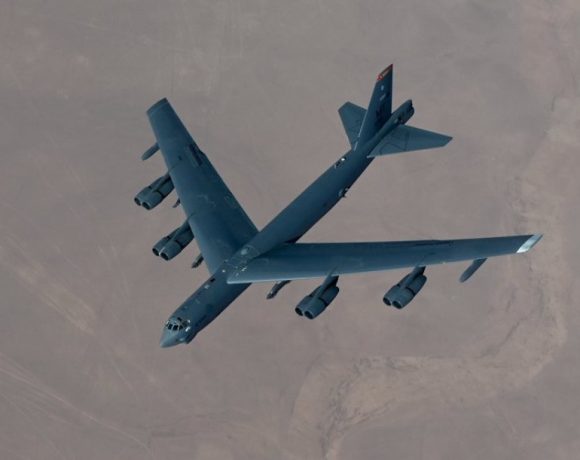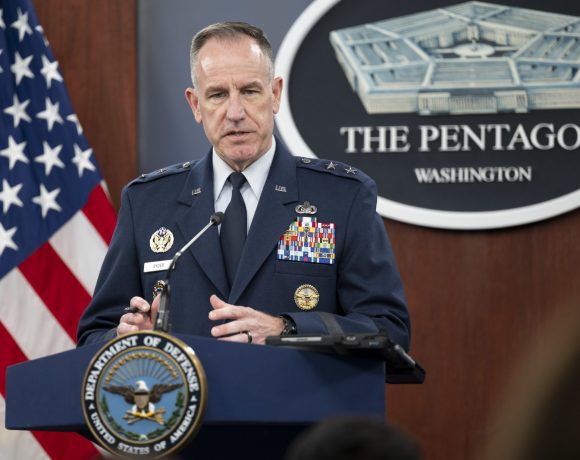2 US B-52H bomber aircraft in Romania for NATO manoeuvres

First time iconic aircraft are in Black Sea region
Two US Air Force B-52H Stratofortress bombers have arrived at Mihail Kogălniceanu Air Base in Romania. This marks the first time US strategic bomber aircraft have operated out of Romania.
The B-52Hs, assigned to the 2nd Bomb Wing, departed Barksdale Air Force Base in Louisiana. While flying in international airspace and adhering to international law, the B-52 aircraft were intercepted by two Russian fighter jets over the Barents Sea.
Unfazed by the Russian interception, the US aircraft demonstrated their resilience and determination. They maintained their course and proceeded with their scheduled flight plan, including coordination with NATO fighter jets, before landing at Mihail Kogalniceanu Air Base.
The two B-52s are pivotal in coordinating missions with NATO allies and partners. This collaboration enhances interoperability, synchronises capabilities, refines tactical procedures among NATO forces, and fosters a deep sense of unity and cooperation.
The B-52s’ deployment to Romania is part of the US’s ongoing Bomber Task Force (BTF) missions, designed to affirm the United States’ commitment to NATO. By showcasing such capabilities, the US reassures its allies and contributes to deterrence efforts, particularly along NATO’s eastern flank.
Watch the video:
Gen Hames Hecker, USAFE-AFAFRICA Commander, said: “In today’s global environment, it is vital that we be postured to deliver a range of sustainable capability from great distances. This iteration of the Bomber Task Force offers an excellent opportunity to refine our agile combat employment tactics, techniques, and procedures.
“Through collaborative efforts with our allies, the US enables our forces to combat current and future threats.”
The B-52H Stratofortress, a cornerstone of the US Air Force’s long-range strike capabilities, is known for its versatility and longevity. Its history, dating back to the 1950s, is a testament to its enduring value in military operations.
Since the 1950s
First introduced in the 1950s, the B-52H Stratofortress has undergone numerous upgrades to remain a formidable asset in modern military operations. Its ability to deliver a wide range of munitions, including precision-guided bombs and nuclear weapons, makes it a pivotal component of U.S. strategic forces, adapting to the changing nature of warfare.
The B-52H Stratofortress is a long-range, heavy bomber designed for various missions. It can fly at high subsonic speeds and reach altitudes up to 15,166.6 metres. The bomber can carry nuclear and precision-guided conventional ordnance and has global navigation capabilities.

The B-52H is powered by eight Pratt & Whitney TF33 engines, which allow it to reach high subsonic speeds. Its unrefuelled combat range is over 14,080 kilometres.
The B-52 can perform strategic attacks, close-air support, air interdiction, offensive counter-air, and maritime operations in conventional conflicts. During Operation Desert Storm, B-52s delivered 40% of all coalition weaponry.
B-52s are particularly effective for ocean surveillance, aiding the US Navy in anti-ship and mine-laying operations. Within two hours, two B-52s can cover 364,000 square kilometres of ocean.
Potential upgrades
All B-52s can be outfitted with electro-optical sensors, forward-looking infrared, and advanced targeting pods to enhance targeting, battle assessment, and flight safety.
Pilots use night vision goggles to improve visibility during night operations, enhancing safety, situational awareness, and aircraft detection.
The B-52H Stratofortress is crucial in US military operations. For instance, it participated in a high-profile mission at Andersen Air Force Base, Guam, in January 2018 and has supported Covid-19 response efforts by flying over medical facilities in Louisiana.
The B-52 has been a cornerstone of the US strategic bomber fleet for over 60 years. It can deliver a wide range of munitions, including gravity bombs, cluster bombs, precision-guided missiles, and joint direct attack munitions.
The B-52 first flew in 1954, with the B-52H model entering service in 1961. The H model is capable of carrying up to 20 air-launched cruise missiles and has seen action in multiple conflicts, including Desert Storm, Enduring Freedom, and Iraqi Freedom.
General characteristics
- Primary function: Heavy bomber
- Manufacturer: Boeing
- Power plant: Eight Pratt & Whitney TF33-P-3/103 turbofan engines
- Thrust: 17,000 pounds per engine
- Wingspan: 56.4 metres
- Length: 48.5 metres
- Height: 12.4 metres
- Weight: Approximately 83,250kg
- Maximum take-off weight: 219,600kg
- Fuel capacity: 141,610kg
- Payload: 31,500kg
- Speed: 650 miles per hour (Mach 0.84)
- Range: 7,652 nautical miles
- Ceiling: 15,151.5 metres
- Armament: Approximately 31,500kg of mixed ordnance, including bombs, mines, and missiles (modified to carry air-launched cruise missiles)
- Crew: Five (aircraft commander, pilot, radar navigator, navigator, and electronic warfare officer)
- Unit cost: $84 million (as of fiscal 2012)
- Initial operating capability: April 1952
- Current inventory: 58 active, 4 in test, 18 in reserve
Featured image: A US Air Force B-52H Stratofortress from the 2nd Bomb Wing, Barksdale Air Force Base, Louisiana, with its crew at Mihail Kogalniceanu Air Base in Romania. Credit: NATO












